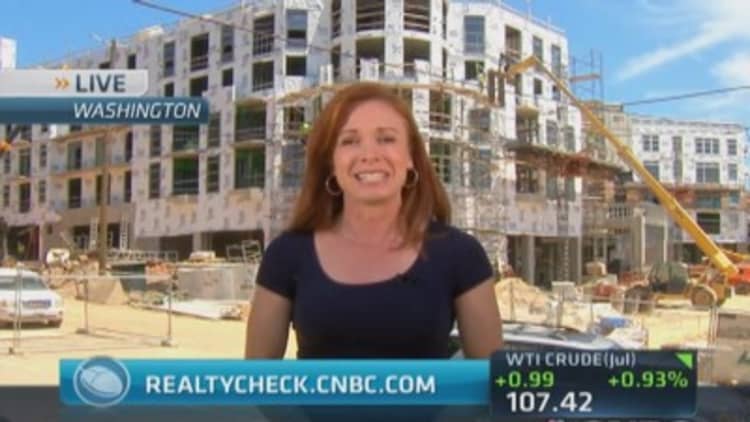
Look up into any window of the closest apartment building and odds are you'll see someone living there. National apartment occupancy in May soared to the highest level in at least six years, according to Axiometrics, an apartment data and research company. Ninety-five percent of all units are filled, even as thousands of new units are becoming available.
"It's a pleasant surprise because it's coming at a time when new supply is flooding the market," said Stephanie McCleskey, Axiometrics' director of research. "One reason occupancy is rising is that, not only are people moving into these new units, but they're also moving into Class B units at a lower price point."
It is especially a surprise to investors, who pulled out of multifamily real estate investment trusts (REITs) last year, as all eyes focused on surging home sales. The S&P index of residential REITs is now up nearly 14 percent from a year ago and up nearly 20 percent year-to-date. Some of the top performers in the sector: Preferred Apartment Communities, Essex and AvalonBay. Weakening affordability in the homebuying market is clearly favoring rentals.
"The rent-buy math remains generally favorable for our Apartment coverage universe," wrote researchers at Deutsche Bank in a recent report. "Though pending supply remains a concern for certain apartment markets in 2014 and 2015, recent revenue growth trends were better-than-expected suggesting that strong demand, buoyed by improving rent-buy dynamics, is helping to offset increases in supply."
About 180,000 new apartment units have become available throughout the U.S. in the past 12 months, according to Axiometrics. Still, growth in rental prices in May was the strongest it's been in 16 months, at 3.5 percent.
Read More Housing starts surge, yes, but mostly for apartments
"The year-to-date effective rent growth numbers portray an apartment market that may be having its strongest year since the Great Recession ended," said Jay Denton, vice president of research at Axiometrics.
Despite the slow recovery in home sales, several factors still fall in favor of renting. Younger Americans are faced with weaker employment, high levels of student debt and general lack of confidence in housing as an investment, at least in the short term.
"We see a number of strong long-term driving forces increasing the rental population and creating demand. Employment rates for millennials draw closer to the national average; the housing recovery is gaining traction, which will push home prices higher; and shorter job tenures create a need for housing mobility," notes Kevin Finkel, an executive vice president with Philadelphia-based Resource Real Estate, an investment firm.
"On the supply side, increasing building material costs will put pressure on the construction of new properties. If interest rates start to trend with economic recovery, added borrowing costs will also inhibit new construction."
Strength in the rental market is fueling a flood of new apps and websites. Swapt, deemed by its creators as the Yelp of apartment rentals, will likely launch out of beta this month. It combines property listings with reviews from renters in a rental search system. It comes on the heels of start-ups like RadPad, PadMapper, HotPads, Apartment Finder, Comfy Rentals and Lovely.
All aim to simplify the rental process, giving landlords and tenants easier access to listings and offering the ability to pay monthly rent on a mobile device.
Read More Real estate's red-hot category: Apartments
"If you look at the rental market, it's the most competitive it's been ever," said Eric Wolfe, CEO of Swapt and a former multifamily analyst at Citi. "The reviews are designed to give people the confidence they need to rent and rent quickly. There is a good amount of money to be made on lead generation."
Wolfe, 31, and a renter himself, does believe demand will soften as the echo boom generation ages into its late 30s and turns to homebuying. He also believes new supply will soften rent growth.
"Demand is still going to be there," he added. "I do think there is room for more unique sites in the space."
—By CNBC's Diana Olick


